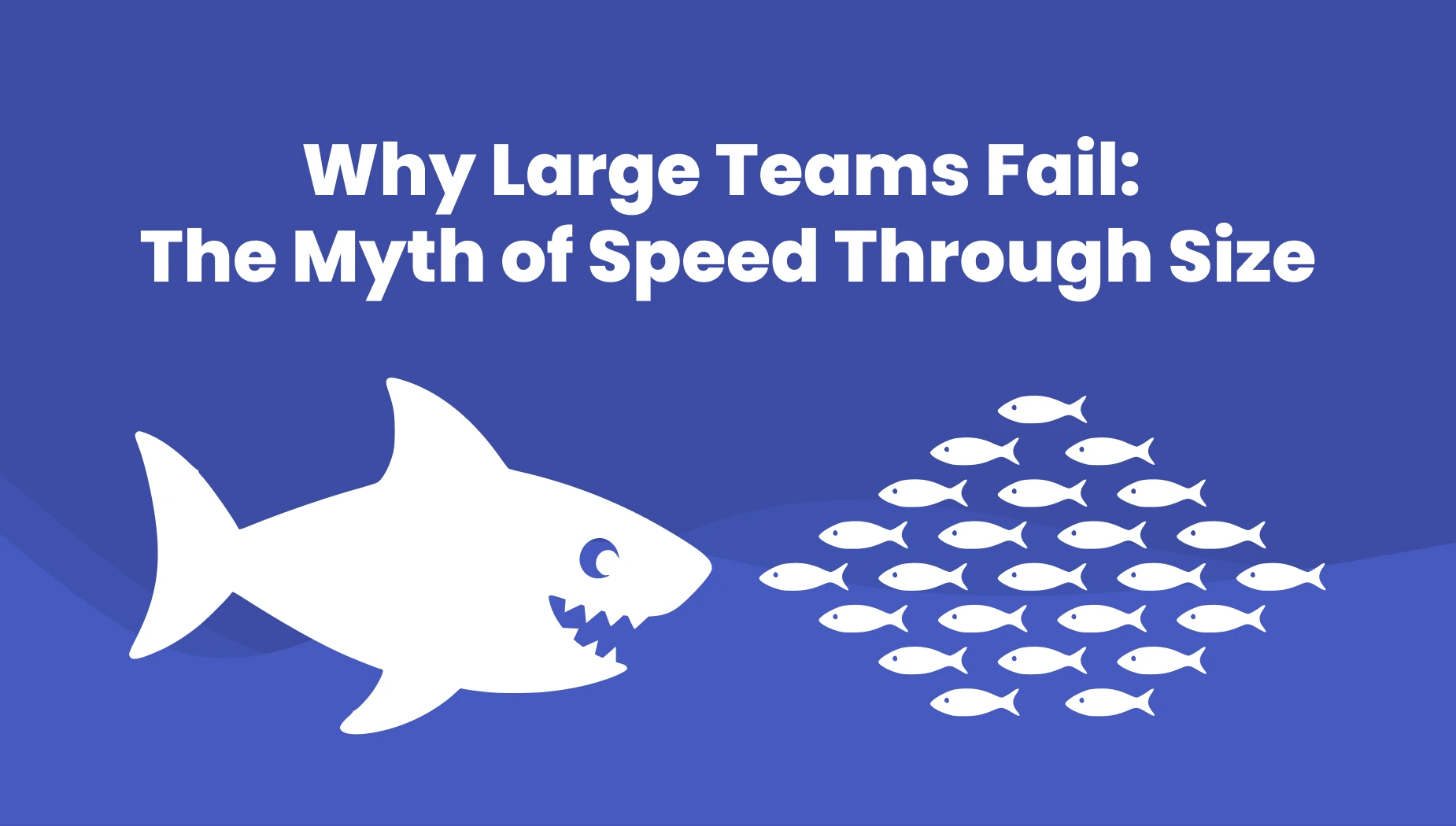Table of Contents
Many founders believe that putting more people on a project will help them reach the finish line faster. It sounds logical — more developers, more output.
But in practice, that assumption rarely works. At Jetruby, we’ve repeatedly seen that starting with a large team often means higher costs, slower results, and lower quality.
This case study explores why small, focused teams consistently outperform larger ones, how rushing the timeline can lead to wasted budgets, and what happens when companies chase promises instead of processes.
1. The Myth of Speed Through Size
It’s one of the oldest misconceptions in software development — the belief that adding more people speeds things up.
In reality, as Steve McConnell famously noted in Rapid Development, every new team member adds communication overhead, decision friction, and management complexity. The team spends more time talking than building.
We’ve seen this play out countless times. A project starts with urgency — “we must launch fast!” — and a large team is assembled to meet the deadline. But soon, the coordination effort grows, priorities blur, and rework begins to consume the budget. The project doesn’t accelerate; it stalls.
At early stages, requirements are still fluid. A small, senior team can adapt quickly and make decisions on the fly. A large one struggles to stay aligned. The result? High costs, missed milestones, and diluted ownership.
When we’re brought in to audit or rescue such projects, the pattern is always the same:
- Communication chaos outweighs coding time
- Technical debt piles up
- Founders lose visibility into what’s actually being built
That’s when clients realize that adding more people was never the answer — they needed clarity, not headcount.
As Fred Brooks wrote in The Mythical Man-Month:
“Adding manpower to a late software project makes it later.”
At JetRuby, we’ve seen this truth confirmed in real life across hundreds of projects — from startups to complex enterprise systems. Speed comes from focus, not from force.
2. Common Objections — and How to Handle Them
Q: “We have a strict deadline — we need more people!”
A: Deadlines require clarity and prioritization, not headcount. A small, synchronized team can move faster by focusing on what truly matters for launch.
Q: “We can afford a large team now — why not scale early?”
A: Because early-stage projects are fluid. More people before clarity means more waste. Build a foundation first, then scale deliberately.
Q: “Our investors expect to see growth in team size.”
A: Growth in metrics, not in payroll, is what impresses investors. Efficiency and traction prove maturity more than inflated teams.
3. Reality Beats Fairy Tales
You can’t “buy” speed with more developers.
True progress comes from well-structured, disciplined teams that understand your goals, adapt quickly, and stay aligned.
At Jetruby, we believe that the right-sized team — small, experienced, and deeply engaged — delivers faster, cleaner, and more predictably than any inflated setup.
Start small. Move fast. Scale wisely.
Real Stories: When “More” Didn’t Mean “Better”
Below are three anonymized real-world cases that illustrate what happens when clients chase headcount or low-cost promises — and why they ultimately return to a focused, small-team approach.
Case 1: Celebrity App Rebuild
A well-known public figure approached us after another outsourcing firm failed to deliver a functional mobile app.
The initial team was large and fragmented — multiple sub-teams, unclear ownership, and no single vision.
When we audited the product, it was clear that most of the codebase had to be rewritten.
Result: We rebuilt the app from scratch with a small, senior-focused team.
The client eventually paid double — once to the previous vendor, and once for the real solution — but this time got a working, maintainable product.
Lesson: Bigger doesn’t mean better — it just multiplies mistakes faster.
Case 2: Digital Publishing Platform Overload
A well-known educational publisher was drawn in by promises of “enterprise-level scaling” from an offshore provider — the result: a bulky, underperforming platform that couldn’t handle real traffic.
When the company came to us, we restructured the system with a small, expert team focused on performance and reliability. Within weeks, the platform met its load requirements and ran smoothly under production stress.
Lesson: Small, specialized teams solve core performance problems faster than large, fragmented ones chasing features.
Case 3: The Low-Cost Detour
Another client — a hardware-connected app startup — worked with Jetruby for months before switching to a “budget-friendly” vendor.
Within a short time, the project stalled completely. Delivery slowed, quality dropped, and deadlines evaporated.
They returned before the product hit an epic fail.
Our compact, high-context team restored the project and stabilized the release process within weeks.
Lesson: Chasing the lowest bid or the largest team often costs more in the end — both in money and in lost time.
Final Thought
In all three cases, the pattern was the same: a large or low-cost team created chaos, while a small, engaged team delivered clarity and success.
At Jetruby, we don’t sell team size — we sell outcomes. Because the right team isn’t the biggest one, it’s the one who truly understands your goals.




